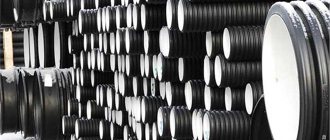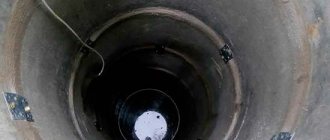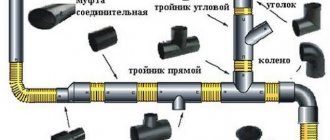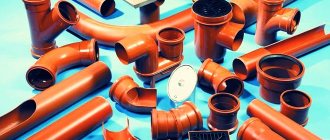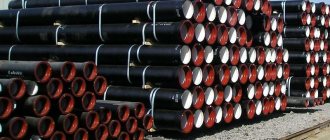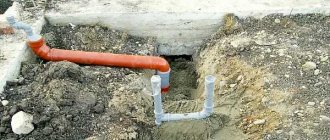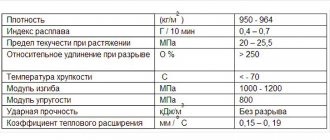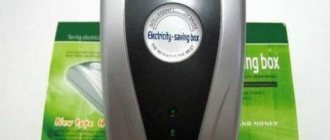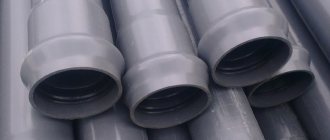Country houses rarely have a connection to a centralized sewerage system.
The owners arrange the drainage themselves. Sewerage installation, both inside and outside the building, requires special attention.
The quality of the pipeline and its efficiency depend entirely on the material from which the main elements are made. Let's consider sewer pipes for external sewerage.
The manufacturer offers products made from PVC, cast iron, polyethylene, polypropylene, reinforced concrete and even ceramics.
Red PVC pipe for sewerage
Products made from polyvinyl chloride are market leaders. They have several advantages among their counterparts:
- Easily tolerates low temperatures
- High level of permissible mechanical load
- Durable
- Have high resistance to aggressive environments and chemicals
- Not subject to corrosion
- Durable
- They don't rot.
The red sewer pipe is manufactured in three modifications, the main difference being the level of strength.
Elements are cast consisting of one layer of PVC - single-layer, and pipes made of two layers of polyvinyl chloride and with a third reinforcing layer - multi-layer.
Parts for the external drainage system are divided into pressure and non-pressure. These types differ in their scope of application.
Non-pressure ones are installed in a sewer system that operates on the principle of gravity flow. Pressure pipes imply the presence of pressure (pressure):
- SN 2 - lightweight thin-walled, class L (2 kN/m2). Designed for installation of pipe lines in areas without road surfaces, installation is carried out at shallow depths, the maximum permissible depth is 2 m.
- SN 4 – medium thin-walled, class N (4 kN/m2). The product is installed under roads with light loads to a depth of up to 6 meters.
- SN 8 – heavy thick-walled, class S (8 kN/m2). Pipes of this model are installed in enterprises and under highways with a depth of up to 8 meters.
Installation features
Let's consider the algorithm for constructing an external sewer system:
- creating a project. It includes the calculation part, layout diagram of components, system elements, specification for materials, components;
- acquisition of necessary materials, pipes, containers;
- production of earthworks. According to the diagram, markings are made, then trenches are dug for laying pipes, nests for containers, wells, and collectors;
- installation of containers, septic tanks, and other reservoirs. In conditions of high groundwater levels, a concrete anchor is first installed at the bottom of the nest to fix the position of the container. Alignment along the axes, waterproofing (if necessary), and insulation are immediately performed;
- Pipelines are being laid. They must have a given slope that corresponds to the diameter of the pipe. So, for elements of 110 mm, the level should decrease by 2 cm for every meter. The larger the diameter, the smaller the optimal slope;
- pipes are insulated. Different materials are used. The best choice is a foam shell. It tightly covers the pipe, completely eliminating the loss of thermal energy;
- tests are being carried out. They pass water through the channels and see how tight the connections are. Detected defects, leaks or other defects are eliminated. After this, the trenches are covered with soil. From this moment the system can be considered put into operation.
This algorithm applies to almost all complexes. Each project has its own characteristics, but the general construction procedure remains unchanged.
Red PVC pipe size
| Outer diameter (mm) | Pipe type | |||||
| SN2 | SN4 | SN8 | ||||
| Wall thickness (mm) | Weight linear meters (kg) | Wall thickness (mm) | Weight linear meters (kg) | Wall thickness (mm) | Weight linear meters (kg) | |
| 110 | — | — | 3,2 | 1,64 | 3,2 | 1,64 |
| 160 | 3,2 | 2,41 | 4,0 | 2,89 | 4,7 | 3,50 |
| 200 | 3,9 | 3,78 | 4,9 | 4,52 | 5,9 | 5,48 |
| 250 | 4,9 | 5,81 | 6,2 | 7,04 | 7,3 | 8,52 |
| 315 | 6,2 | 9,22 | 7,7 | 11,11 | 9,2 | 13,50 |
| 400 | 7,9 | 15,00 | 9,8 | 17,90 | 11,7 | 21,80 |
| 500 | 9,8 | 22,20 | 12,3 | 27,75 | 14,6 | 34,68 |
Sewage elements are cast smooth-walled and corrugated.
Corrugated pipes are multilayer. The outer side is corrugated, the inner side has a smooth structure. The products have good flexibility.
Smooth pipes are cast in one layer of PVC.
To assemble a sewer system, most products with a cross section of 110 and 160 mm are used. (for laying between buildings) and 200mm when running along the street.
A pipe with a cross-section of 110 mm is installed:
- To remove wastewater from a residential building
- For installation of sewerage systems in the private sector
- For surface sewerage.
Attention. Orange PVC pipes are susceptible to deformation at high temperatures. Operating range -50 degrees to 50 degrees Celsius. Short term load capacity 90 degrees.
Ways to fight
You can avoid emergency situations and prevent sewer pipes from freezing in the ground by using the following tips:
The laying of the sewerage pipeline must be carried out to a certain depth. It is recommended to place it below the freezing level. The fact is that temperatures at this level do not fall below 1-2°C. This indicator is optimal and allows work to be carried out without the use of insulating materials. If the work is carried out by non-professionals, then this rule is not observed. Pipes are laid above the freezing level, which can create an unusual situation during severe frosts and lead to a breakthrough. This method of deepening is needed when sewer insulation is carried out in a private house, and the owners do not live here permanently. Special materials designed for thermal insulation should be used. The pipes are carefully covered with material that has high thermal insulation properties. It slows down the cooling process and heat loss. Pipe heating is also used using an electric cable specially designed for this purpose. If it is necessary to insulate a device that is subject to freezing, then the pipes are sloped. It is at least 2 cm for every meter. In this case, an electric cable is laid outside the pipe, performing the functions of a heater. In its absence, the pipes freeze, and the frozen water in them forms ice jams.
As a result, the sewer system fails. It is important to properly insulate ventilation pipes. They are located outside, and are brought to the roof surface from the sewer riser
Some of them come from underground and serve to ventilate a septic tank or sewer tanks. When wastewater evaporates, it settles on the inner sides of the pipes. Over time, they freeze and fill the entire system. Residents begin to smell the stench due to a broken ventilation system. The situation can be corrected by pouring a bucket of water into the frozen riser. Only after this should it be insulated. If an electric cable is used for insulation, it must be packaged in corrugation. A plastic container will also work. This will ensure the longevity of the ventilation system.
uPVC sewer pipes
UPVC is not an upgraded polyvinyl chloride. Used to assemble pipelines under highways and buildings.
Suitable for drainage, storm drainage, and industrial use.
Important. UPVC has a high level of resistance to almost all types of aggressive chemical environments.
Characteristic:
- Yellow or brown tint
- Diameter from 110-1000 mm
- Lungs
- Three-layer
- Not affected by chemicals
- Service life 50 years
For your information. This type of pipe has the same classification as PVC products: SN2, Sn4, SN8.
Obvious disadvantages:
- Operating temperature -5- +60 degrees. Almost 100% probability of freezing when laying in regions with low temperatures.
- When melting, aggressive toxins are released
- Rodents often damage pipes.
Cast iron pipes
Cast iron products are used for the construction of external sewage systems. This is due to their characteristics.
- Very durable
- Durability, service life up to 100 years
- Capable of withstanding heavy loads
- Thanks to the anti-corrosion coating, they are less susceptible to rust.
Pipes are available in two versions:
- SMU – products with the same diameter along the entire length, with even cuts, without special connecting elements.
- SME - pipes are cast with a one-way detachable connection.
The main disadvantages of this product are its heavy weight, which greatly complicates installation, and the rough inner surface, which allows dirt to settle on the walls.
Attention. If a cast iron pipe is allowed to freeze, it may burst.
Plastic products for external sewerage
It is recommended to install PP and PE plastic pipes in places with high dynamic impact (vehicle traffic, operation of machines and mechanisms, etc.).
PP – polypropylene . They are gray in color. In most cases, they install sewerage inside the building. For external sewerage systems, high-strength PP products are used. Operating temperature from -5 degrees to +60.
Attention. A gray pipe can withstand a temperature of 95 degrees for no more than a minute, and at -10 degrees it becomes brittle.
PE – polyethylene .
Pipes with thick walls, which affects their price and weight. There is a good analogue of reinforced polyethylene pipes, which are perfect for assembling an external drainage system.
How and with what to insulate a sewer pipe in the ground?
Thermal insulation of sewer pipes is carried out using rolled and rigid insulation, in particular:
cotton wool Mineral or basalt (110-125 rubles/sq.m.) or glass wool (70-75 rubles/sq.m.), which is sold in rolls or in the form of rigid cylinders. Cotton insulation is an excellent solution only if it provides additional protection from moisture. By the way, cotton wool in cylinders is denser, but also more expensive (from 15 rubles/m.m. regular, from 70 rubles/m.m. foil);
polystyrene foam (2560-3200 rubles/cube) or polystyrene foam or penoplex (3500-5000 rubles/cube). These materials are classified as rigid insulation materials. The simplest and cheapest way to insulate a sewer system with polystyrene foam is to build a box around the pipe and then fill it with cotton wool or foam chips (crushed chips, polystyrene chips).
There is a more progressive material for sewer insulation based on styrene - this is a polyurethane foam shell (on average 190 rubles/m.p. with a thickness of 25 mm). The maximum thickness of the PU shell is 100 mm.
The shell for pipes made of polystyrene foam is characterized by rigidity and a variety of internal diameters, due to which the shell firmly and tightly grips the pipe, providing the necessary indicator of tightness. Due to the fact that the range of sizes of polystyrene foam shells is quite wide, it is possible to perform double insulation with offset. According to the manufacturers, the sewer system will not freeze even at an outside temperature of -30 °C.
Foamed polyethylene for sewer pipes Foamed polyethylene for pipes (28 RUR/m.p.). The internal diameter varies from 15 to 160 mm (fixed length - 2 meters). Insulation for sewer pipes 110 mm. Due to the ease of installation and low cost, its installation is only advisable in warm climate zones.
Insulation of sewer pipes with foamed polyethylene
Pipe thermal insulation made of foamed polyethylene
penofol (50-56 rubles/sq.m.). Thanks to the foil layer, the effect of a thermos is achieved.
penoizol - sprayed insulation. It is often used to insulate a septic tank and sewer pipeline together. Allows for perfect sealing.
expanded clay (60 rubles/bag (0.4 cubic meters)). Refers to bulk insulation. Sewer insulation with expanded clay is effective only if the trench in which the pipes are laid is absolutely dry. Therefore, expanded clay is often poured into a foam box.
Expanded clay has proven itself well for insulating storm drains, which also drain water into the septic tank and can create blockages when melt or rainwater freezes in it. Therefore, storm pipes also need insulation. Since in this case it is difficult to protect thermal insulation materials from moisture, expanded clay becomes an ideal insulation material.
Asbestos cement pipes
Asbestos cement consists of Portland cement (calcium silicate base and its derivatives) and asbestos fibers (minerals from the silicate class).
Main advantages of the products:
- Long service life
- Not a lot of weight
- High resistance to chemicals
- Minimal pipe fouling
A significant disadvantage of asbestos cement is its fragility and inability to withstand mechanical damage.
Recommendation. When purchasing pipes made from this material, special attention should be paid to the cuts. They often have chips and cracks, which is unacceptable during installation.
Methods for insulating sewer systems
Let's look at several ways to insulate sewer systems that will save you money and won't take much effort during installation.
There are also several other easy ways to insulate sewer pipes.
Method one
The easiest way, it seemed, was to bury the pipes below the freezing level of the soil. But, taking into account that depending on the continental location, each city and suburb has its own level of soil freezing.
Burying pipes below freezing ground is one of the simplest ways. Click to enlarge.
And you will be lucky if it is no more than a meter on your site.
Then there are many more factors why this method of protecting sewer pipes may not be available.
The main factors include the structural features of the soil, proximity to groundwater, the presence of harmful substances and insects that destroy the structure of the pipes. Therefore, such insulation of sewer pipes may not be possible.
It is also worth taking into account repairs in case of a pipe break. It is not necessary that the water supply can freeze; there are a lot of influences, the results of which lead to malfunctions on any section of the laid pipe
It is not necessary that the water supply can freeze; there are a lot of influences, the results of which lead to malfunctions on any section of the laid pipe.
And in order to repair the damaged area, you will have to dig up the pipe again, and it will be good if it is noticeable where the breakdown occurred, and if not, then dig it out completely, and in this case you will have to change it.
So, although this method will cost you little, it is not practical.
Second way
The second method involves insulating sewer pipes by laying an electrical cable. This method is quite reliable, and applies not only to external insulation, but also in houses with a poor heating system.
And the main thing is complete dependence on power supply.
That is, if your electricity is turned off for some reason, you will not receive heating of the pipes.
The second drawback is the hefty bills for electricity consumption. And if something burns out there, or a pipe bursts, it can lead to a short circuit, or, even worse, a fire.
Third way
How to insulate a sewer system in a way that is not resource-intensive and safe, a method is proposed that involves the use of appropriate insulation materials.
Before purchasing such materials, you should pay attention to important properties:
- Durability
- Moisture protection
- Ease of installation
- Flammability
- Material cost
It is also worth considering the characteristics of the insulating material and the possibility of reuse.
Ceramic pipes
Ceramics have been used to make sewerage elements since ancient times. It maintains its position to this day.
+
Pumping of all liquids, including chemicals, is allowed- Absolutely smooth inner walls prevent the formation of deposits.
- Easily tolerates any ambient temperature.
- Easy installation.
—
- Short product length, which increases the number of joints.
- Increased fragility
Important. Transportation and installation of ceramic products require careful handling.
Pipes with a diameter of 100 to 600 mm are manufactured, with a socket or thread for connection.
Leading manufacturers of sewer pipes
- Wavin - Holland. Specialization: plastic pipes.
- POLIPLAST – Russia, Kazakhstan, Belarus (joint production). They produce sewer pipes from PE, PP, PAKH, and fiberglass.
- Ostendorf - Germany. Profile line of sewer pipes KG.
- Politek – Russia. Products made from polymers are an ideal ratio of price and quality.
- Duker - Germany. Specialization: cast iron pipes.
- Saint-Gobain - France. Cast iron pipes for underground installation and drainage systems.
To choose the right sewer pipes, several points should be taken into account:
- Material of manufacture
- Installation location
- Operating conditions
